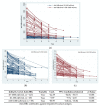Duration of Hepatitis B Vaccine-Induced Protection among Medical Students and Healthcare Workers following Primary Vaccination in Infancy and Rate of Immunity Decline
- PMID: 35214725
- PMCID: PMC8878162
- DOI: 10.3390/vaccines10020267
Duration of Hepatitis B Vaccine-Induced Protection among Medical Students and Healthcare Workers following Primary Vaccination in Infancy and Rate of Immunity Decline
Abstract
Since the introduction of hepatitis B virus (HBV) vaccines, the numbers of HBV infections and complications have significantly decreased. However, the evidence on whether primary vaccination of infants confers lifelong immunity varies. We aimed to assess long-term immunity among healthcare workers and medical students, and the rate of decline of HBV surface antigen antibodies (anti-HBs). Hepatitis B status among participants born after 1 January 1992 was reviewed at Chulabhorn Royal Academy, Thailand. Participants were stratified by intervals since primary vaccination. HBV immunity was determined and analyzed as anti-HBs decline rate in participants with multiple follow-ups. A total of 464 participants were analyzed, with a median age of 23. Protective immunity against HBV (anti-HBs ≥ 10 mIU/mL) at 16-20, 21-25 and 26-28 years post-primary vaccination was 28%, 51.7% and 60%, respectively. The overall declining rate of anti-HBs was -42.39 mIU/mL per year. Participants with anti-HBs levels of >100-1000 mIU/mL at baseline had a faster decline rate than those with anti-HBs levels of 10-100 mIU/mL. Primary vaccination may not provide lifelong protection since HBV immunity deteriorates over time. Individuals with higher initial HBV immunity levels may experience a faster decline rate.
Keywords: healthcare workers; hepatitis B; primary vaccination; rate of immunity decline.
Conflict of interest statement
The authors have no conflict of interest to declare.
Figures
Similar articles
-
Persistence of hepatitis B surface antibody and immune memory to hepatitis B vaccine among medical college students in Madinah.Ann Saudi Med. 2018 Nov-Dec;38(6):413-419. doi: 10.5144/0256-4947.2018.413. Ann Saudi Med. 2018. PMID: 30531175 Free PMC article.
-
Long-term persistence in protection and response to a hepatitis B vaccine booster among adolescents immunized in infancy in the western region of China.Hum Vaccin Immunother. 2017 Apr 3;13(4):909-915. doi: 10.1080/21645515.2016.1250990. Epub 2016 Nov 22. Hum Vaccin Immunother. 2017. PMID: 27874311 Free PMC article.
-
Predictive factors for anti-HBs status after 1 booster dose of hepatitis B vaccine.Medicine (Baltimore). 2016 Sep;95(39):e5023. doi: 10.1097/MD.0000000000005023. Medicine (Baltimore). 2016. PMID: 27684874 Free PMC article.
-
Expression and detection of anti-HBs antibodies after hepatitis B virus infection or vaccination in the context of protective immunity.Arch Virol. 2019 Nov;164(11):2645-2658. doi: 10.1007/s00705-019-04369-9. Epub 2019 Aug 9. Arch Virol. 2019. PMID: 31399876 Review.
-
Long-Term Effectiveness of Hepatitis B Vaccination in the Protection of Healthcare Students in Highly Developed Countries: A Systematic Review and Meta-Analysis.Vaccines (Basel). 2022 Oct 30;10(11):1841. doi: 10.3390/vaccines10111841. Vaccines (Basel). 2022. PMID: 36366350 Free PMC article. Review.
Cited by
-
Level of antibody to hepatitis B surface antigen declined below 10 mIU/ml is still protective.NPJ Vaccines. 2025 Jun 18;10(1):126. doi: 10.1038/s41541-025-01188-9. NPJ Vaccines. 2025. PMID: 40533440 Free PMC article.
-
A Comprehensive Review of Hepatitis B Vaccine Nonresponse and Associated Risk Factors.Vaccines (Basel). 2024 Jun 25;12(7):710. doi: 10.3390/vaccines12070710. Vaccines (Basel). 2024. PMID: 39066348 Free PMC article. Review.
-
Seroprevalence Study of Anti-HBs Antibodies in the General Population of Vojvodina, Serbia.Medicina (Kaunas). 2024 Mar 6;60(3):436. doi: 10.3390/medicina60030436. Medicina (Kaunas). 2024. PMID: 38541162 Free PMC article.
-
Increasing Prevalence of Occult HBV Infection in Adults Vaccinated Against Hepatitis B at Birth.Vaccines (Basel). 2025 Feb 12;13(2):174. doi: 10.3390/vaccines13020174. Vaccines (Basel). 2025. PMID: 40006721 Free PMC article.
-
Prevalence of hepatitis B surface antibody among previously vaccinated healthcare workers in Tashkent, Uzbekistan.Hum Vaccin Immunother. 2024 Dec 31;20(1):2435142. doi: 10.1080/21645515.2024.2435142. Epub 2024 Dec 18. Hum Vaccin Immunother. 2024. PMID: 39693189 Free PMC article.
References
-
- Hepatitis B Fact Sheet. [(accessed on 1 December 2021)]. Available online: http://www.who.int/mediacentre/factsheets/fs204/en/
-
- Guidelines for Viral Hepatitis Surveillance and Case Management. [(accessed on 1 December 2021)]; Available online: https://www.cdc.gov/hepatitis/statistics/surveillanceguidelines.htm.
-
- Thailand’s Achievement on Hepatitis B Control. [(accessed on 1 December 2021)]. Available online: https://www.who.int/thailand/news/detail/08-08-2019-thailand-achievement....
-
- WHO Hepatitis B Report, 2017. Executive Summary. [(accessed on 1 December 2021)]. Available online: https://www.who.int/publications/i/item/global-hepatitis-report-2017.
Grants and funding
LinkOut - more resources
Full Text Sources
Medical


